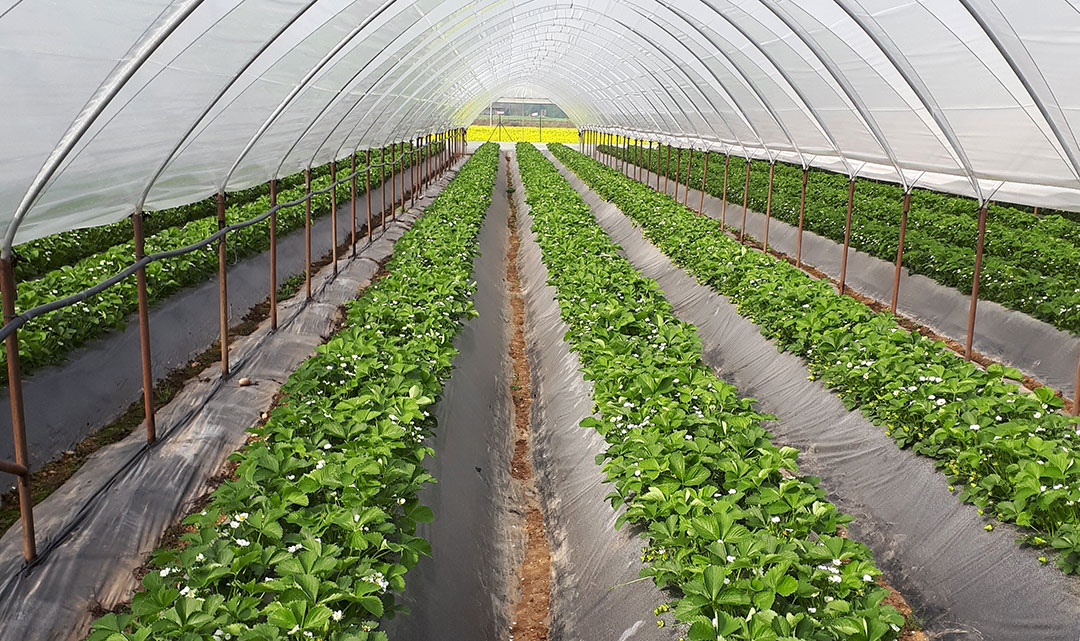The strawberry fertilization plan is a subject of study for any agricultural production company to improve and adjust since the profitability of its cultivation depends largely on it.
On a global level, strawberry cultivation is widespread in the main international agricultural markets, and is present on all continents, with the largest strawberry exporters being Mexico, Spain, and the United States, although the consumer values local products.
Strawberry cultivation in the province of Huelva (Spain) covers an area of 6,000 hectares, representing more than 97% of Spanish production and is one of the major players in the Spanish agricultural sector and the sector’s export capacity to other European countries, mainly in the months of March and April.
In the new strawberry cultivation systems, the correct use of biostimulant products and biocontrol products is essential for a fertilization plan that allows us to obtain the optimal production levels for the profitability of the farmer or agricultural company, in which progress continues at the level of scientific research and in which the development of agricultural biostimulant products and biocontrol does not cease, aimed at obtaining optimal production levels for the profitability of the farmer or agricultural company.

Strawberry varieties cultivated in Spain.
Current strawberries belong mainly to the species Fragaria x ananassa Duch, an octoploid species that largely supports why it is highly adapted to a wide variety of climates and soils. If varietal improvements and cultivation techniques are added to this, its productivity improves enormously.
In the context of strawberry cultivation, its floral induction is not only produced in response to the photoperiod but also the temperature and genotype interact in it. In addition, other factors affect this process, highlighting the nutrition of the plant, such as, specifically, nitrogen levels.
Focusing on the photoperiod, strawberry varieties are classified into three groups: short-day, long-day, and neutral-day. In the case of Spain, as we have already mentioned, the production area is centred on temperate areas (Huelva), with the best adapted varieties being those with “short days”.

The variety game is not stable, varying from campaign to campaign depending on the appearance of new varieties, adaptation to cultivation dates, etc. Thus, and to be more exact, we can see how this distribution is during the 2023-2024 campaign.
One of the most accurate sources for this is the Instituto de Investigación y Formación Agraria y Pesquera (Ifapa), through the Plataforma de Asesoramiento y Transferencia del conocimiento agrario y pesquero de Andalucía (Servifapa). According to the technical report, the most used strawberry varieties in the 2023/2024 campaign by Huelva’s Strawberry producers are Marisma (10.7%), Fortuna (10.5%) and Rociera (10.1%).
Other varieties that configure the varietal panorama in a representative way and in order of importance are Red Sayra, Leticia, Palmeritas, Victory, Calinda, Arwen, Marimbella, Felicity, Fandango, Primavera, Gioletita, …
Advances in the use of biostimulants in strawberry cultivation.
Maintaining the quality of the soil or substrate is essential to obtain optimal production levels, without the appearance of physiopathies caused by high salinity and other problems that come from poor absorption of nutrients.
It is important for the technician to know the variety behaviour in order to establish the correct planting framework and the adequate nutritional balance supported by the corresponding biostimulant products that will help improve the crop’s performance, with a better root system, a supply of quickly assimilated substances that allow the energy saving of the plant that invests in an increase in size and quality.
Within the strawberry fertilization plan, JISA highlights the physiological inducing biostimulants, the Cuajemax® flowering and fruit setting inducer and the Engormax® biostimulant with algae extract and amino acids. As a metabolic activator root system activator, the Libamin® radicular. And as for microorganisms, Vitatek®, formulated from a consortium of PGPR bacteria with a biostimulant effect, which increases the vigor of the plant and the yield of the crops.

Strawberry fertilization must be rational and must be adapted to the cultivation phase and envibehaviorronmental conditions. Remember that strawberries grow better in soils with a slightly acidic pH, between 6 and 6.5. If these have an alkaline reaction, symptoms of iron chlorosis appear, more or less pronounced depending on the variety cultivated. In cases of risk, the contribution of iron is vital. Among the JISA products, its liquid formulation Nutrijisa® hierro, as well as the solid formulation of EDDHA iron chelate in the form of microgranules Jisaquel® Fe S-6 are effective in maintaining the good condition of the plant.
Continuing with needs that compromise the crop, water stress caused by extreme temperatures and humidity, as well as by its sensitivity to salinity, requires the appropriate use of desalinators, humic acids and biostimulants with an osmoprotective effect such as Glybet®.
As we can see, there are several factors involved in strawberry cultivation, being a correct fertilization one of the most important.
For more information on JISA products or if you have any technical questions regarding strawberry cultivation, please feel free to reach out to our Technical-Commercial team.
